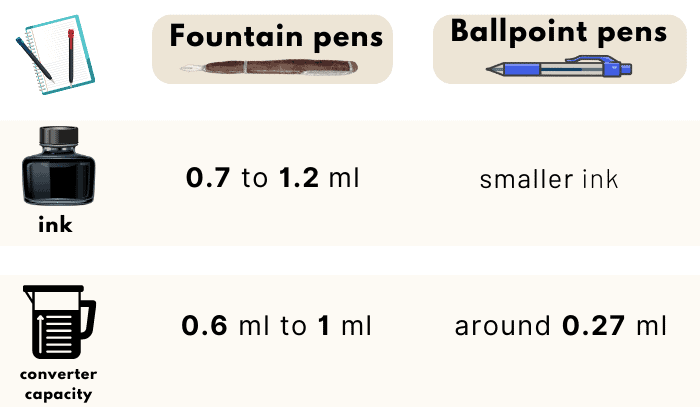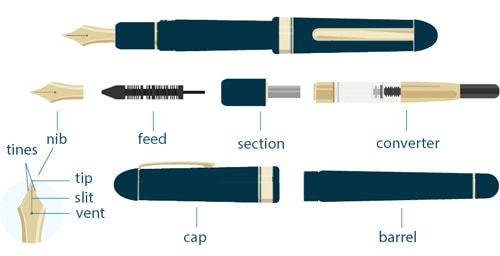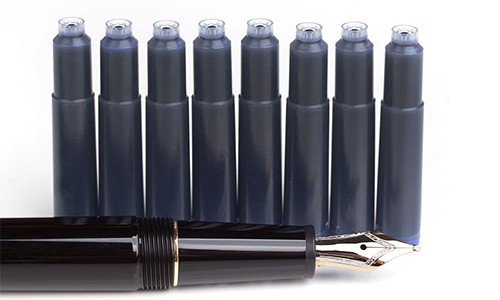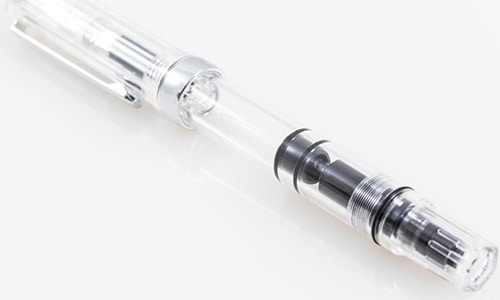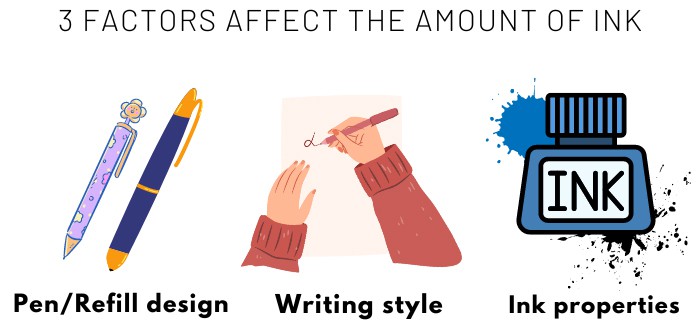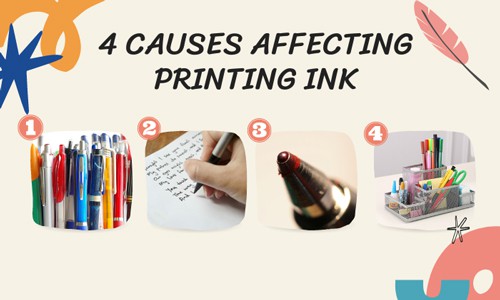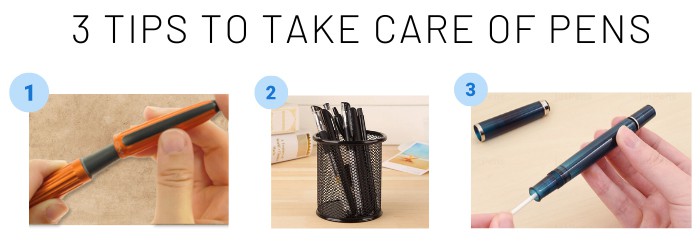Have you ever wondered how much ink is in a pen? What are the factors that affect the amount of ink in a pen? On average, there is around 1ml of ink in a pen, which might last about 300 pages. Indeed, the exact volume will vary in different types.
Dive in to explore the maximum ink storage capabilities of various pen types, uncover the mechanisms that regulate ink flow, and method to measure the amount of ink.
Table of Contents
How Many Ml is in a Pen?
The amount of ink in a pen can vary depending on the pen type:
Fountain pens:
- Fountain pen cartridges hold between 0.7 to 1.2 ml of ink.
- Fountain pen converter capacity can range from 0.6 ml to 1 ml.
Ballpoint pens:
- Ballpoint pens generally have smaller ink capacities compared to fountain pens.
- The ink capacity of a ballpoint pen is typically around 0.27 ml.
The Anatomy of a Pen
Fountain pens
A fountain pen comprises several specific components:
- Cap
- Barrel
- Nib
- Feed
- Section
- Converter
Ballpoint pens
A ballpoint pen consists of:
- Tip/Nose Cone
- Ink Chamber/Cartridge
- Spring
- Barrel
- Thrust device/Cam
How Pens Store Ink
Fountain pens cartridges
How much ink is in a cartridge? The maximum ink capacity of fountain pen cartridges is 1.2 ml.
- These fountain pens can use disposable ink cartridges, which are pre-filled ink containers.
- These cartridges are typically made of plastic or metal and have a seal that keeps the ink fresh until it is inserted into the pen.
- Cartridges come in standardized sizes and can be easily replaced when empty. This mechanism is convenient and mess-free because there is no need to handle any ink converter or bottled ink for fountain pens.
Fountain pen converters
A fountain pen converter/ refillable pen capacity is 1 ml maximum.
- A converter is a reusable component that allows you to fill a fountain pen with bottled ink.
- It replaces the need for disposable cartridges and provides a more sustainable and cost-effective solution for ink refilling.
- Converters come in 2 types (piston and squeeze converters), but their function is the same.
- They have an internal mechanism that creates a vacuum or draws in ink when operated. Converters typically have a mouth or opening to immerse in ink, an ink reservoir, and a seal to prevent leakage.
When you twist or turn the piston or plunger on the converter, the ink will be drawn inside. This action creates a vacuum that fills the converter with ink. Your ink is now kept in the converter.
Ballpoint pens
The maximum ink storage of a ballpoint pen is 0.27 ml.
- The ink is stored or kept in a sealed and pressurized ink chamber in a ballpoint pen.
- It is designed with a small opening or channel that allows the ink to flow to the ballpoint when you write.
- The ballpoint pen contains oil-based paste ink, so it won’t dry out easily.
- The pen is designed with a unique mechanism called “capillary action”.
This mechanism helps prevent ink from flowing when there is no pressure or when the pen’s tip is not in contact with the paper’s surface. Thus, ink is stored in the nozzle and chamber when you’re not writing.
Factors Affecting Ink Capacity
- Pen/Refill design: The overall design of the fountain pen or the refill can influence its ink capacity. Pens with larger barrels or reservoirs tend to have a higher ink capacity than slimmer or compact pens.
- Writing style: Individual writing style and frequency of use can impact ink capacity. Those who write extensively or with heavier pressure may consume ink more quickly, requiring more frequent refills.
- Ink properties: The characteristics of the ink for pens can affect its capacity. Inks with higher viscosity or density may require larger reservoirs or cartridges to hold enough ink.
Measuring Ink Quantity
Measure ink capacity
You can use a syringe to measure the ink capacity of a pen. Below are detailed steps to do it:
- Step 1: Ensure the pen is full to measure the ink capacity accurately.
- Step 2: Take a clean and dry syringe with volume markings. Attach a blunt needle to the syringe.
- Step 3: Insert the needle or adapter into the ink cartridge or converter.
- Step 4: Pull the ink from the ink cartridge into the syringe till it’s empty.
- Step 5: Read the level line on the cartridge. That’s the capacity of your pen.
You can estimate pen ink consumption through the pages:
- Track the ink levels in the pen before and after writing a certain number of pages.
- Once you know the maximum number of pages you can write with your full ink cartridge pens, you can estimate how much ink you consume.
- This estimation method provides a rough approximation and may vary depending on individual writing habits and ink flow consistency.
Factors influencing ink usage
- Pen type: Different types of pens, such as ballpoint, rollerball, or fountain pens, have varying ink flow mechanisms that can affect ink consumption.
For example, ink in a gel pen or a fountain pen is more than ink in a ballpoint pen.
- Writing speed: Faster writing speed may increase ink flow, especially with pens with a ball or rollerball mechanism.
- Pen tip size: Pens with larger tip sizes generally deposit more ink on the page, leading to higher ink usage than pens with smaller tips.
- Pen storage: Proper pen maintenance and storage can ensure efficient ink usage and prevent wastage.
The Signs to Tell Pen is Out of Ink
- Fading or skipping: If the pen starts to produce faint or inconsistent lines, it’s a sign that the ink level is low.
- Increased pressure required: If you need to apply more pressure or press down harder on the paper to get the ink to flow smoothly, the pen is running out of ink.
- Visual inspection: Some fountain pens have translucent bodies that allow you to see the ink level directly. If you can see that the ink is below a certain level, it’s a clear sign that it’s time for a refill.
Tips to Store a Pen to Make It Last Longer:
- 1. Always cap your pen when it’s not in use to prevent the ink from drying out and protect its nib from damage.
- 2. Store pens horizontally or upright to help maintain consistent ink flow and prevent leakage or pooling.
- 3. Clean the pen properly before storage.
Pen Brands and Ink Capacities
Different ink capacities offered by various brands:
- Standard cartridge: Fountain pen brands, such as Pelikan and Kaweco, hold around 1.2 ml of ink maximum.
Meanwhile, Lamy has a 1.15 ml ink pen capacity, and the Sailor ink cartridge capacity is 1.0 ml (0,034 ounces)
- Converter: Pilot fountain pens have 0.9 ml of maximum ink storage, while Waterman only holds 0.6 ml, and Twsbi Eco ink capacity is 1.8 ml.
Pros and cons of high and low ink capacity pens:
|
|
Pros |
Cons |
|
High ink capacity pens |
|
|
|
Low ink capacity pens |
It’s convenient to carry them in pockets or bags without excessive bulk. |
|
Frequently Asked Questions
How Long Does Pen Ink Last?
Ink performance and longevity can range from 5 to 50 years, varying on the specific brand, formulation, and storage conditions.
How long does fountain pen ink last? Fountain pen ink can last 10 to 60 years, depending on the brand and regular maintenance.
Can I Mix Inks From Different Pens?
Yes. It’s safe to mix one color of ink with another color, but mixing ink from the same brand is recommended. When mixing ink, it’s best to use a new and clean container to avoid contaminating the ink.
Are There Pens With Transparent Ink Reservoirs?
Yes. Pens with transparent ink reservoirs or barrels allow you to see the ink level.
This feature is particularly common in fountain pens, where the transparency of the barrel allows you to see the ink sloshing around inside or check the ink level directly.
Conclusion
How much ink is in a pen? Fountain pens offer various ink capacities depending on the pen model and design.
Piston fillers and ink cartridge sizes usually range from 0.7 to 1.2 ml. On the other hand, converter options provide capacities from 0.6 to 1 ml. Ballpoint pens usually hold 0.27 ml ink maximum.
Considering the ink capacity that suits your writing needs is important for prolonged writing sessions or frequent refilling requirements.

Art has always been a part of my life; it influences my upbringing and later my career choice. For me, it is always a part of my parenting technique. So for whichever purpose that you come to art, you can start here with us.

